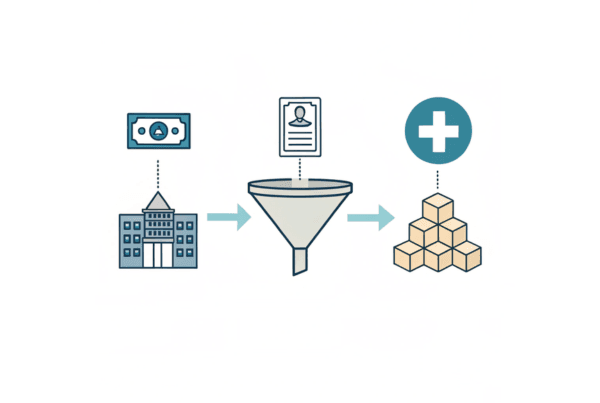The market for ABA services is growing, creating significant opportunities for practice owners in Montana considering a sale. Selling your home-based ABA practice is a major decision that goes beyond just finding a buyer. It requires careful planning around valuation, timing, and post-sale life. This guide provides a clear overview of the current landscape and the steps you can take to prepare for a successful and profitable transition.
A Growing Market for ABA Services
The decision to sell your practice is deeply personal. It also depends on market conditions. Right now, the market for ABA services is strong, both nationally and within Montana. Understanding these dynamics is the first step in positioning your practice for a premium valuation.
National Tailwinds
The demand for Applied Behavior Analysis is rising across the country. The U.S. ABA market is projected to grow at a steady 4.8% annual rate through 2032. This growth is driven by increased awareness and diagnosis of autism spectrum disorder, as well as broader insurance coverage for ABA therapies. For you, this means there is a growing pool of sophisticated buyers, including private equity firms and larger strategic providers, who are actively looking to acquire well-run practices.
The Montana Advantage
In a rural and geographically dispersed state like Montana, home-based service models are particularly valuable. Your practice has a low overhead structure and a proven ability to deliver care directly to families, which is a significant strategic advantage. Buyers recognize this. They see the potential for scalability and the deep community roots that your practice has established, making it a more attractive acquisition target than a facility-based model in a more saturated market.
Key Considerations for Your Practice
A potential buyer will look at more than just your revenue. They are buying your future cash flow and your operational strengths. Before you even think about putting your practice on the market, it is important to look at it from a buyer’s perspective. How much does the practice rely on you personally? A business that can run smoothly with its existing team of therapists and administrative staff is far more valuable than one dependent on a single owner. We see this all the time. Similarly, buyers need to see clean, clear financial records that accurately reflect the practice’s true profitability. Taking the time now to organize your books and professionalize your operations is not just good practice. It directly increases what a buyer is willing to pay.
What the Market Activity Shows
The M&A market for healthcare practices is active. While every transaction is unique, we can look at broader trends in the home-based care sector to understand the current environment. Buyers are paying healthy prices for profitable, well-managed businesses. Data from recent transactions provides a helpful benchmark for what you might expect.
| Market Indicator | Current Data | What This Means for You |
|---|---|---|
| National ABA Market Growth | 4.8% CAGR (2024-2032) | There is sustained and growing demand for your services. |
| Typical Valuation Multiple | 2.2x – 3.6x SDE | Profitable practices are commanding strong valuations. |
| Home-Based Deal Volume | 169+ deals since 2010 | The market is mature with a history of successful sales. |
This data shows a consistent appetite for home-based healthcare businesses. For Montana ABA practice owners, this translates into a favorable seller’s market. However, achieving a valuation at the higher end of the range depends entirely on running a structured sale process that creates competitive tension among qualified buyers. Relying on a single, unsolicited offer rarely results in the best outcome.
Navigating the Sale Process
Selling your practice is a marathon, not a sprint. The most successful sales we see are those where the owner started preparing years in advance. The process generally involves several key phases. It starts with getting your financial and operational house in order. Next comes creating confidential marketing materials and identifying a curated list of potential buyers. Once interest is generated, you move into negotiations, leading to a letter of intent. The final, and often most intense, phase is due diligence, where the buyer verifies every aspect of your business. This is where many deals fall apart without proper preparation. A structured process, guided by experienced advisors, protects your confidentiality and ensures you are controlling the timeline, not reacting to it.
Understanding Your Practice’s True Value
Determining the value of your ABA practice is both an art and a science. While a multiple of earnings is the common starting point, what a buyer is willing to pay depends on a deeper story. At its core, valuation looks at a few key things.
- Adjusted Earnings. This is not just the profit on your tax return. We calculate your Seller’s Discretionary Earnings (SDE), which adds back your salary and other personal benefits to show the total cash flow available to a new owner.
- Profit Margins. The average gross profit margin for home health businesses is around 35%. Practices that meet or exceed this demonstrate strong operational health and command higher interest.
- Growth Potential. Are you in a growing part of Montana? Do you have a waitlist of clients? A clear path to future growth is something a buyer will pay a premium for today.
- Practice Stability. As we mentioned, a practice with a strong team of therapists that doesn’t rely solely on you is seen as less risky and therefore more valuable.
A comprehensive valuation is the foundation of any successful sale. It sets a realistic price expectation and becomes the cornerstone of your negotiation strategy.
Planning for Life After the Sale
The day you sign the closing papers is not the end of the process. It is the beginning of a transition. Thinking about this phase early is critical. How will you ensure a smooth handover for your dedicated staff and the families you serve? The structure of the deal has major tax implications, and planning ahead can protect a significant portion of your hard-earned proceeds. You also need to decide what your role will be, if any. Some owners want a clean break, while others prefer to stay on for a period to ensure continuity or participate in future growth. Protecting your legacy is just as important as maximizing your sale price. A thoughtful transition plan ensures the practice you built continues to thrive and that you are set up for the next chapter of your life.
Frequently Asked Questions
What factors influence the valuation of a home-based ABA practice in Montana?
The valuation is influenced by adjusted earnings (Seller’s Discretionary Earnings), profit margins (around 35% is typical), growth potential (such as location and client waitlist), practice stability (reliance on owner vs. team), and how well financial and operational aspects are organized.
Why is the home-based model valuable in Montana for ABA services?
Montana’s rural and geographically dispersed nature makes home-based service models valuable because they have low overhead and proven ability to deliver care directly to families. This model is scalable and has deep community roots, making it attractive to buyers.
What should an owner do to prepare their ABA practice for sale?
Owners should organize clean and clear financial records, professionalize operations, reduce reliance on the owner by strengthening the team, and start planning years in advance. This preparation ensures a structured sale process and maximizes valuation.
What are the key phases involved in selling a home-based ABA practice?
The sale process generally involves: 1) Getting financial and operational house in order, 2) Creating confidential marketing materials, 3) Identifying and attracting potential buyers, 4) Negotiations and letters of intent, 5) Due diligence for buyer verification, and 6) Closing and transition planning.
What considerations are important for planning life after selling an ABA practice?
After the sale, owners should plan a smooth handover for staff and clients, consider tax implications of the deal structure, decide on any ongoing role, and develop a transition plan to protect their legacy and ensure the practice’s continued success.



